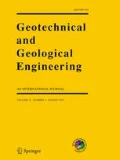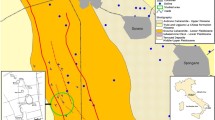Abstract
This research work deals with the problem of karst sinkhole collapse occurring in the last few years in Cheria area (NE Algeria). This newly revealed phenomenon is of a major constrain in land use planning and urbanization, it has become necessary to locate and assess the stability of these underground features before any planning operation. Several exploration methods for the localization of underground cavities have been considered. Geological survey, discontinuity analysis, resistivity survey [ground penetrating radar has not been used as most of the Mio-Plio-Quaternary filling deposit covering Eocene limestone contains clay layers which limits the applicability of the method (Roth et al. in Eng Geol 65:225–232, 2002)] and borehole drilling were undertaken in order to locate underground cavities and assess their depth, geometry, dimensions, etc. Laboratory testing and field work were also undertaken in order to determine both intact rock and rock mass properties. All the rock mechanics testing and measurement were undertaken according to the ISRM recommendations. It has been found that under imposed loading, the stability of the karst cavities depends on the geo-mechanical parameters (RMR, Rock Mass Rating; GSI, Geological Strength Index; E, Young modulus) of the host rock as well as the depth and dimensions of the gallery. It increases with RMR, GSI, E and depth and decreases as the cavity becomes wider. Furthermore, the calculation results show that a ratio (roof thickness to gallery width) of 0.3 and more indicate, a stable conditions. The results obtained in this work allow identifying and assessing the stability of underground karst cavities. The methodology followed in this paper can be taken as a road map in the establishment of a hazard map related to the studied phenomenon. This map will be a useful tool for the future urban extension planning in Cheria area.









Similar content being viewed by others
References
Abdulla WA, Goodings DJ (1996) Modeling of sinkholes in weakly cemented sand. J Geotech Eng 122(12):998–1005
ANONYME (1973–1975) Fiche technique des forages : F9, J8-9bis, JK8, OJ1, F2, BBC1, CH1, CH2, et CH4… etc. (DHW : direction d’hydraulique de la wilaya de Tébessa)
Baali F (2007) Contribution à l’étude hydrgéologique, hydrochimique et vulnérabilité à la pollution d’un système aquifère karstique en zone semi aride. E algérien, Cas du plateau de Chéria N
Beck BF, Sinclair WC (1986) Sinkholes in Florida: an introduction. Florida Sinkhole Research Institute Report 85-86-4, 16 pp
Benson RC, La Fountain LJ (1984) Evaluation of subsidence or collapse potential due to subsurface cavities. In: Proceedings of the first multidisciplinary conference on sinkholes. Balkema, Rotterdam, pp 201–215
Bieniawski ZT (1973) Engineering classification of jointed rock masses. Trans South Afr Inst Civil Eng 15:335–343
Bieniawski ZT (1976) Rock mass classification in rock engineering. In: Bieniawski ZT (ed) Proceedings of the symposium on exploration for rock engineering, vol 1, pp 97–106
Chaffai H et al. (1986) Evaluation des ressources en eaux de la plaine de Chéria (NE Algérie). Synthèse et analyse des données. Doctorat 3ème cycle, USTL, Montpellier II, 245p
Currin JL, Barfus BL (1989) Sinkhole distribution and characteristics in Pasco County, Florida. In: Proceedings of third multidisciplinary conference on sinkholes and the engineering and environmental impacts of karst. Balkema, Rotterdam, pp 97–106
Davis EH, Gunn MJ, Mair RJ, Seneviratne HN (1980) The stability of shallow tunnels and underground openings in cohesive material. Geotechnique 30:397–416
de Groot-Hedlin C, Constable SC (1990) Occam’s inversion to generate smooth, two-dimensional models from magnetotelluric data. Geophysics 55:1613–1624
Durozoy et Lamber (1947) Compte rendu la tournée effectuée dans la région de Tébessa (plateau de Chéria) A.N.R.H de Tébessa. 40 p
Fehdi C, Baali F, Boubaya D, Rouabhia A (2011) Detection of sinkholes using 2D electrical resistivity imaging in the Cheria Basin (north–east of Algeria). Arab J Geosci 4:181–187
Ford DC, Williams PF (1989) Karst geomorphology and hydrology. Unwin Hyman, London, p 601
Gaud B (1978) Eude géologique et hydrogéologique du plateau de Chéria Wilaya de Tébessa. Rapport interne N°2. A.N.R.H de Tébessa 68p (Agence Nationale des ressources hydriques)
Gertje H, Jeremias AE (1989) Building construction over an erosive sinkhole site: a case study in Lancaster County, Pennsylvania, USA. In Proceedings of third multidisciplinary conference on Sinkholes and the engineering and environmental impacts of karst. Balkema, Rotterdam, pp 311–318
Goodings DJ, Abdulla WA (2002) Stability charts for predicting sinkholes in weakly cemented sand over karst limestone. Eng Geol 65(2002):179–184
Hall LA, Metcalfe SJ (1984) Sinkhole collapse due to groundwater pumpage for freeze protection irrigation near Dover, Florida, January 1977. In: Burger A, Dubertret L (eds) Hydrogeology of karst terrains, vol 1, pp 248–251
Kaufmann O, Quinif Y (2002) Geohazard map of cover-collapse sinkholes in the ‘Tournaisis’ area, southern Belgium, Nottingham. Eng Geol 75:15–31
Klimchouk AB (2000) The formation of epikarst and its role in vadose speleogenesis. In: Klimchouk AB, Ford DC, Palmer AN, Dreybrodt W (2007) (eds) Speleogenesis: evolution of karst aquifers. National Speleological Society, Huntsville, pp 91–99
LaBrecque DJ, Ramirez AL, Daily WD, Binley AM, Schima SA (1996) ERT monitoring of environmental remediation processes. Meas Sci Technol 7:375–383
Lamont-Black J, Younger PL, Forth RA, Cooper AH, Bonniface JP (2002) A decision logic framework for investigating subsidence problems potentially attributable to gypsum karstification. Eng Geol 65(2–3):205–215
Loke MH, Barker RD (1996) Rapid least-squares inversion of apparent resistivity pseudosections by a quasi-Newton method. Geophys Prospect 44:131–152
Roje-Bonacci T (1997) Influence of the fluctuation of groundwater levels upon the formation of sinkholes. In: Proceedings of the international conference on engineering geology and the environment, vol 1, Athens, pp 997–1002
Roth MJS, Mackey JR, Mackey C, Nyquist JE (2002) A case study of the reliability of multielectrode earth resistivity testing for geotechnical investigations in karst terrains. Eng Geol 65:225–232
Sowers GF (1975) Failures in limestones in humid subtropics. J Geotech Eng Div ASCE 101(GT8):771–787
Stringfield VT, Rapp JR (1976) Land subsidence resulting from withdrawal of groundwater in carbonate rocks. In: Proceedings of second international symposium on land subsidence, Anaheim (USA)
Tharp TM (1999) Mechanics of upward propagation of covercollapse sinkholes. Eng Geol (Amsterdam) 52:23–33
Waltham AC (1989) Ground subsidence. Blackie, Glasgow, p 202
Waltham AC, Swift GM (2004) Bearing capacity of rock over mined cavities in Nottingham. Eng Geol 75:15–31
Waltham T, Bell F, Culshaw M (2005) Sinkholes and Subsidence; karst and cavernous rocks in engineering and construction. Springer, Berlin 382 pp
Yang MZ, Drumm EC (2002) Stability evaluation for the siting of municipal landfills in karst
Author information
Authors and Affiliations
Corresponding author
Rights and permissions
About this article
Cite this article
Yacine, A., Ridha, M.M., Laid, H.M. et al. Karst Sinkholes Stability Assessment in Cheria Area, NE Algeria. Geotech Geol Eng 32, 363–374 (2014). https://doi.org/10.1007/s10706-013-9719-2
Received:
Accepted:
Published:
Issue Date:
DOI: https://doi.org/10.1007/s10706-013-9719-2




